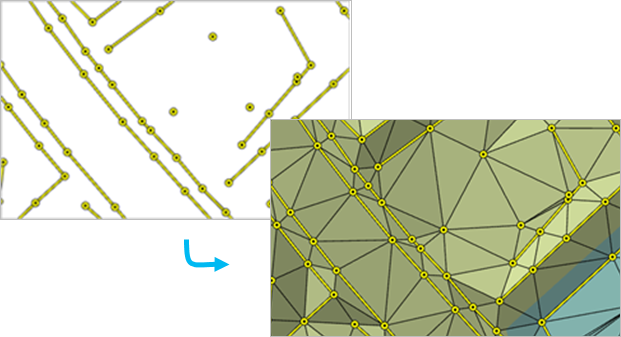| Label | Explanation | Data Type |
Output TIN | The TIN dataset that will be generated. | TIN |
Coordinate System (Optional) | The spatial reference of the output TIN. Set the spatial reference to a projected coordinate system. Geographic coordinate systems are not recommended because Delaunay triangulation cannot be guaranteed when the x,y coordinates are expressed in angular units, which could have an adverse impact on the accuracy of distance-based calculations, such as slope, volume, and line of sight. | Coordinate System |
Input Feature Class (Optional) | The input features and their related properties that will contribute to the definition of the TIN.
| Value Table |
Constrained Delaunay (Optional) | Specifies the triangulation technique that will be used along the breaklines of the TIN.
| Boolean |
Summary
Creates a triangulated irregular network (TIN) dataset.
Illustration

Usage
-
Avoid creating a TIN using a geographic coordinate system, as the Delaunay triangulation rule cannot be effectively enforced when the x,y units are expressed in spherical coordinates.
-
The surface feature type defines how the input features will contribute to the definition of the triangulated surface.
- Point features can be specified as mass points, which provide data nodes with z-values that are used in the triangulation of the surface.
- Line features can be specified as mass points and breaklines, which represent locations along a surface with linear discontinuities in slope, such as ridge lines, shore lines, pavement edges, building footprints, and so on.
- Polygon features can also be specified as mass points and breaklines, along with clip features that define the data area, replace features that define regions with constant z-values (for example, water bodies), and erase features that indicate interior areas where data does not exist.
-
The tool can create a TIN composed of many millions of points given enough memory. However, limiting the number of TIN nodes to less than 6 million will ensure a responsive display performance and overall usability. Larger TIN surfaces are best managed using a multiresolution terrain dataset. When working with point cloud data in the LAS format, the LAS dataset can be used to efficiently render and process LAS points in a TIN surface that incorporates the same polyline and polygon based surface constraints supported in a TIN dataset.
-
Set the Default TIN Storage Version environment setting to PRE_10.0 if the TIN being created will be used in versions of ArcGIS Desktop earlier than 10.0.
Once a TIN dataset is created, you can modify it using the Edit TIN tool to incorporate additional feature-based measurements into the TIN surface. You can also use the Delineate TIN Data Area tool to define which TIN triangles constitute the interpolation zone based on the maximum length of a triangle edge. The TIN surface can also be modified through interactive editing.
Parameters
arcpy.ddd.CreateTin(out_tin, {spatial_reference}, {in_features}, {constrained_delaunay})| Name | Explanation | Data Type |
out_tin | The TIN dataset that will be generated. | TIN |
spatial_reference (Optional) | The spatial reference of the output TIN. Set the spatial reference to a projected coordinate system. Geographic coordinate systems are not recommended because Delaunay triangulation cannot be guaranteed when the x,y coordinates are expressed in angular units, which could have an adverse impact on the accuracy of distance-based calculations, such as slope, volume, and line of sight. | Coordinate System |
in_features [[in_features, height_field, SF_type, tag_value],...] (Optional) | The input features and their related properties that will contribute to the definition of the TIN.
| Value Table |
constrained_delaunay (Optional) | Specifies the triangulation technique that will be used along the breaklines of the TIN.
| Boolean |
Code sample
The following sample demonstrates the use of this tool in the Python window.
arcpy.env.workspace = "C:/data"
arcpy.ddd.CreateTin("NewTIN", "NAD 1983 StatePlane California II FIPS 0402 (Feet).prj",
"points.shp Shape.Z masspoints", "constrained_delaunay")The following sample demonstrates the use of this tool in a stand-alone Python script.
'''****************************************************************************
Name: Define Data Boundary of LAS File
Description: This script demonstrates how to delineate data boundaries of
LAS files with irregularly clustered points. It is intended for
use as a script tool with one input LAS file.
****************************************************************************'''
# Import system modules
import arcpy
# Set local variables
inLas = arcpy.GetParameterAsText(0) # input LAS file
ptSpacing = arcpy.GetParameterAsText(1) # LAS point spacing
classCode = arcpy.GetParameterAsText(2) # List of integers
returnValue = arcpy.GetParameterAsText(3) # List of strings
outTin = arcpy.GetParameterAsText(4) # TIN created to delineate data area
outBoundary = arcpy.GetParameterAsText(5) # Polygon boundary file
try:
# Execute LASToMultipoint
lasMP = arcpy.CreateUniqueName('lasMultipoint', 'in_memory')
arcpy.ddd.LASToMultipoint(inLas, LasMP, ptSpacing, class_code,
"ANY_RETURNS", "", sr, inFormat, zfactor)
# Execute CreateTin
arcpy.ddd.CreateTin(outTin, sr, "{0} Shape.Z masspoints"\
.format(lasMP), "Delaunay")
# Execute CopyTin
arcpy.ddd.CopyTin(outTin, "{0}_copy".format(outTin))
# Execute DelineateTinDataArea
maxEdge = ptSpacing * 4
arcpy.ddd.DelineateTinDataArea(outTin, maxEdge, "PERIMETER_ONLY")
# Execute TinDomain
arcpy.ddd.TinDomain(outTin, outBoundary, "POLYGON")
except arcpy.ExecuteError:
print(arcpy.GetMessages())
except Exception as err:
print(err)